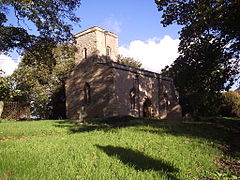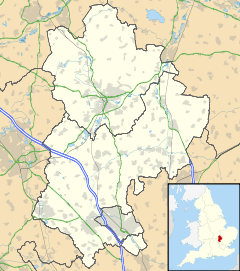- Farndish
-
Coordinates: 52°15′43″N 0°38′46″W / 52.26190°N 0.64610°W
Farndish
Farndish church
 Farndish shown within Bedfordshire
Farndish shown within BedfordshirePopulation 40 (2001) OS grid reference SP925635 Parish Podington Unitary authority Bedford Ceremonial county Bedfordshire Region East Country England Sovereign state United Kingdom Post town NORTHAMPTON Postcode district NN29 Dialling code 01933 Police Bedfordshire Fire Bedfordshire and Luton Ambulance East of England EU Parliament East of England UK Parliament North East Bedfordshire List of places: UK • England • Bedfordshire Farndish is a very small and rural village in northwest Bedfordshire, located about 500 metres east of the county border with Northamptonshire which is also the postal county. The village is near the Northamptonshire villages of Irchester and Wollaston and the Bedfordshire village of Wymington. The name Farndish means fern-clad pasture.
Although previously a parish itself, today Farndish is within the civil parish of Podington (sometimes called Podington and Hinwick) and part of the electoral ward of Harrold in the Bedford local authority in East of England region. Much property in the area is owned by the local Saxby family – once famous locally for their pork pies and pastry.
Contents
History
Farndish was mentioned in the Domesday Survey as 'Fernadis'.
According to Samuel Lewis
“ Farndish is a parish in the Hundred of Willey, and the county of Bedford, 4½ miles (S.W. by S.) from Higham-Ferrers, containing 73 inhabitants. The church living is a rectory, in the archdeaconry of Bedford, and diocese of Lincoln, rated in the king's books at £10. C. Chester, Esq. was patron in 1784. ” The local author H. E. Bates often would come through the village on his nocturnal walks in the 1920s and 1930s. It was on one of the night walks that he got the inspiration for his first novel, The Two Sisters, when he saw a light burning in one of the cottage windows.
The church
The church of St Michaels & All Angels appears to have been built sometime between 1180 and 1210. The masonry used to build the church is mainly local rubble along with some rust-coloured ironstone; the window dressings are of local limestone.
The tower was added in the 15th century within the nave and houses three bells:
- Treble – cast by Christopher Grave – 1663
- Second – cast by James Keene – 1625
- Tenor – cast by Newcombe – 1597
The font dates to circa 1200 and is crowned by a 17th century wooden cover – this is itself covered in 19th century inscriptions and patterns. The very low pitched roof still has its original 15th century timberwork.
According to "Kelly's Directory – the church is "a small building of stone, in the Transitional, Early English and later styles, consisting of chancel, nave and a low western tower rising within the nave, and containing 3 bells : the south doorway is a rich example of the Transitional Norman style : a beautiful stained east window was presented by the late Mr. W. H. S. Adcock, of this village, one on the south side by the Rev. Greville Chester, late rector, and there are several other stained windows : in the chancel is a small brass to John Johnston, rector (ob. 1625), being then nearly 100 years old; and there are also inscriptions to the Clark, Adcock and Alderman families : the church plate includes an ancient chalice : there are 69 sittings. The register dates from the year 1587."[2]
- The parish records for the church and village are available on microfiche for the period 1550-1812 from the Bedfordshire Family History Society.
- Since 1970, the Church has been redundant but remains consecrated; since 1974 it has been maintained by the Redundant Churches Fund and the donations of visitors. Repairs to the Church have been carried out for the fund by the Bedford architect Victor Farrar.
- There is a healthy population of bats living in the belfry of the church.
References
- ^ "A Topographical Dictionary of England – Samuel Lewis – 1831"
- ^ "Kelly's Directory – Bedfordshire – 1898"
External links
 Media related to Farndish at Wikimedia CommonsCategories:
Media related to Farndish at Wikimedia CommonsCategories:- Villages in Bedfordshire
- Places in Bedfordshire listed in the Domesday Book
Wikimedia Foundation. 2010.





